Louis Comfort Tiffany
| Louis Comfort Tiffany | |
|---|---|
 c.1908 |
|
| Born | February 18, 1848 New York, New York |
| Died | January 17, 1933 (aged 84) New York, New York |
| Resting place | Greenwood Cemetery |
| Education | Pennsylvania Military Academy Eagleswood Military Academy |
| Known for | Favrile glass |
| Spouse | Mary Woodbridge Goddard (c1850-1884) |
| Parents | Charles Lewis Tiffany Harriet Olivia Avery Young |
Louis Comfort Tiffany (February 18, 1848 – January 17, 1933) was an American artist and designer who worked in the decorative arts and is best known for his work in stained glass. He is the American artist most associated with the Art Nouveau and Aesthetic movements. Tiffany was affiliated with a prestigious collaborative of designers known as the Associated Artists, which included Lockwood de Forest, Candace Wheeler, and Samuel Colman. Tiffany designed stained glass windows and lamps, glass mosaics, blown glass, ceramics, jewelry, enamels and metalwork.[1]
Contents |
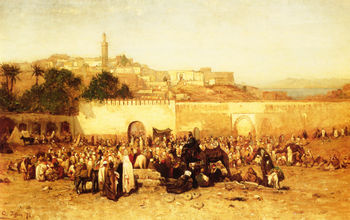
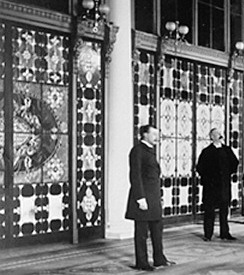
Early life
Tiffany was the son of Charles Lewis Tiffany, founder of Tiffany and Company; and Harriet Olivia Avery Young. He attended school at Pennsylvania Military Academy[2] in Chester, Pennsylvania, and Eagleswood Military Academy in Perth Amboy, New Jersey. His first artistic training was as a painter, studying under George Inness and Samuel Colman in New York City and Léon Bailly in Paris.
Career
Tiffany started out as a painter, but became interested in glassmaking from about 1875 and worked at several glasshouses in Brooklyn between then and 1878. In 1879, he joined with Candace Wheeler, Samuel Colman and Lockwood de Forest to form Louis Comfort Tiffany and Associated American Artists. Tiffany's leadership and talent, as well as by his father's money and connections, led this business to thrive.
In 1881 the Tiffany did interior design of the Mark Twain House in Hartford, Connecticut, which still remains, but the new firm's most notable work came in 1882, when President Chester Alan Arthur refused to move into the White House until it had been redecorated, and commissioned Tiffany, which had begun to make a name for himself in New York society for the firm's interior design work, to redo the state rooms, which Arthur found charmless. Tiffany worked on the East Room, the Blue Room, the Red Room, the State Dining Room and the Entrance Hall, refurnishing, repainting in decorative patterns, installing newly designed mantelpieces, changing to wallpaper with dense patterns, and, of course, adding Tiffany glass to gaslight fixtures, windows and adding the opalescent floor to ceiling glass screen in the Entrance Hall.[3][4][5]
A desire to concentrate on art in glass led to the breakup of the firm in 1885, when Tiffany chose to establish his own glassmaking firm later that same year. The first Tiffany Glass Company was incorporated on December 1, 1885, and in 1902 became known as the Tiffany Studios.
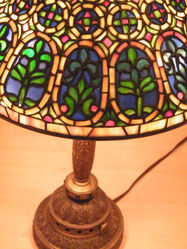
In the beginning of his career, Tiffany used cheap jelly jars and bottles because they had the mineral impurities that finer glass lacked. When he was unable to convince fine glassmakers to leave the impurities in, he began making his own glass. Tiffany used opalescent glass in a variety of colors and textures to create a unique style of stained glass. This can be contrasted with the method of painting in glass paint or enamels on colorless glass that had been the dominant method of creating stained glass for several hundred years in Europe. (The First Presbyterian Church building of 1905 in Pittsburgh, Pennsylvania is unique in that it uses Tiffany windows that partially make use of painted glass.) Use of the colored glass itself to create stained glass pictures was motivated by the ideals of the Arts and Crafts movement and its leader William Morris in England. Fellow artist and glassmakers Oliver Kimberly and Frank Duffner, founders of the Duffner and Kimberly company, and John La Farge were Tiffany's chief competitors in this new American style of stained glass. Tiffany, Duffner and Kimberly, along with La Farge, had learned their craft at the same glasshouses in Brooklyn in the late 1870s.
In 1893, Tiffany built a new factory called the Stourbridge Glass Company, later called Tiffany Glass Furnaces, which was located in Corona, Queens, New York. In 1893, his company also introduced the term Favrile in conjunction with his first production of blown glass at his new glass factory. Some early examples of his lamps were exhibited in the 1893 World's Fair in Chicago. At the Exposition Universelle (1900) in Paris, he won a gold medal with his stained glass windows The Four Seasons
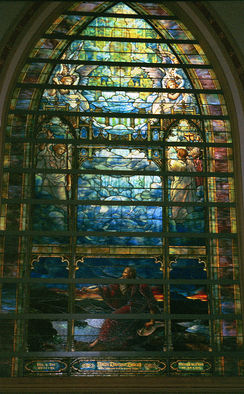
He trademarked Favrile (from the old French word for handmade) on November 13, 1894. He later used this word to apply to all of his glass, enamel and pottery. Tiffany's first commercially produced lamps date from around 1895. Much of his company's production was in making stained glass windows and Tiffany lamps, but his company designed a complete range of interior decorations. At its peak, his factory employed more than 300 artisans. Recent scholarship led by Rutgers professor Martin Eidelberg suggests that a team of talented single women designers led by Clara Driscoll played a big role in designing many of the floral patterns on the famous Tiffany lamp as well as for other creations.[6][7][8][9][10]
Tiffany interiors also made considerable use of mosaics. The mosaics workshop, largely staffed by women, was overseen until 1898 by the Swiss-born sculptor and designer Jacob Adolphus Holzer.
In 1902, Tiffany became the first Design Director for Tiffany & Co., the jewelry company founded by his father.[11]
Tiffany used all his skills in the design of his own house, the 84-room Laurelton Hall, in the village of Laurel Hollow, on Long Island, New York completed in 1905. Later this estate was donated to his foundation for art students along with 60 acres (243,000 m²) of land, sold in 1949, and destroyed by a fire in 1957.
The Charles Hosmer Morse Museum of American Art in Winter Park, Florida houses the world's most comprehensive collection of the works of Louis Comfort Tiffany, including Tiffany jewelry, pottery, paintings, art glass, leaded-glass windows, lamps, and the chapel interior he designed for the 1893 World's Columbian Exposition in Chicago. After the close of the exposition, a benefactor purchased the entire chapel for installation in the crypt of the Cathedral of Saint John the Divine, New York in New York City. As construction on the cathedral continued, the chapel fell into disuse, and in 1916, Tiffany removed the bulk of it to Laurelton Hall. After the 1957 fire, the chapel was rescued by Hugh McKean,[12] a former art student in 1930 at Laurelton Hall, and his wife Jeannette Genius McKean,[13] and now occupies an entire wing of the Morse Museum which they founded. Many glass panels from Laurelton Hall are also there; for many years some were on display in local restaurants and businesses in Central Florida. Some were replaced by full-scale color transparencies after the museum opened. A major exhibit at New York's Metropolitan Museum of Art on Laurelton Hall opened in November 2006. An exhibit at the New-York Historical Society in 2007 featured new information about the women who worked for Tiffany and their contribution to designs credited to Tiffany.[14] In addition, since 1995 the Queens Museum of Art has featured a permanent collection of Tiffany objects, which continues Tiffany’s presence in Corona, Queens where the company's studios were once located.
The only Tiffany windows outside of the United States are in the American Church in Paris on the Quai d'Orsay. They are classified as National Monuments by the French government and were commissioned by Rodman Wanamaker in 1901 for the original American Church building on the right bank of the Seine. The Haworth Art Gallery in Accrington, England has the largest public collection of Tiffany glass in Europe.[15]

Family
Louis married Mary Woodbridge Goddard (c1850-1884) on May 15, 1872 in Norwich, Connecticut and had the following children:
- Mary Woodbridge Tiffany (1873-1963) who married Graham Lusk;
- Charles Louis Tiffany I (1874-1874);
- Charles Louis Tiffany II (1878-1947); and
- Hilda Goddard Tiffany (1879-1908), the youngest.
After the death of his wife, he married Louise Wakeman Knox (1851-1904) on November 9, 1886. They had the following children:
- Louise Comfort Tiffany (1887-1974);
- Julia DeForest Tiffany (1887-1973) who married Gurdon S. Parker then married Francis Minot Weld;[16]
- Annie Olivia Tiffany (1888-1892); and
- Dorothy Trimble Tiffany (1891-1979), who, as Dorothy Burlingham, later became a noted psychoanalyst and lifelong friend and partner of Anna Freud.
Many of Tiffany's descendants are active in the arts, politics, and the sciences. Only one descendant is working in glass today — Dr. Rodman Gilder Miller of Seattle, Washington.
Death
Tiffany died on January 17, 1933, and is buried in Green-Wood Cemetery in Brooklyn, New York.[17]
Societies
- American Watercolor Society
- Chevalier of the Legion of Honour in 1900
- National Academy of Design in 1880
- Societé des Beaux Arts
- Society of American Artists in 1877
Gallery
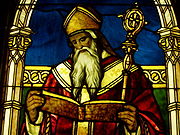 Window of St. Augustine, in the Lightner Museum, St. Augustine, Florida. |
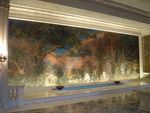 The Dream Garden by Louis Comfort Tiffany and Maxfield Parrish |
Girl with Cherry Blossoms (c. 1890) |
The Tree of Life stained glass |
 The New Creation, at Brown Memorial Presbyterian Church, Baltimore, Maryland |
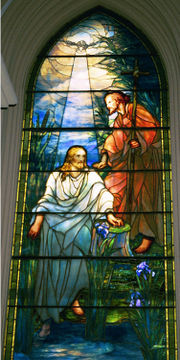 The Baptism of Christ, at Brown Memorial |
 The Annunciation to the Shepherds, at Brown Memorial |
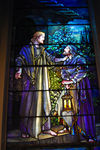 Nicodemus Came to Him by Night, First Presbyterian Church, Lockport, NY |
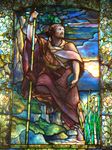 John the Baptist at Arlington Street Church in Boston |
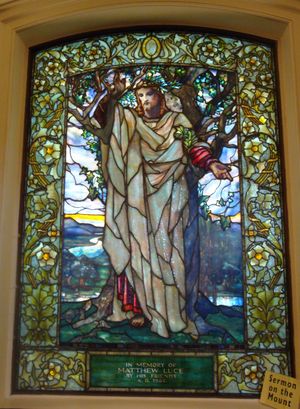 Sermon on the Mount at Arlington Street Church in Boston |
|
"Education" in Linsly-Chittenden Hall at Yale University |
See also
|
|
References
- Notes
- ↑ William Warmus. The Essential Louis Comfort Tiffany. New York: Abrams, 2001. Pages 5-8.
- ↑ "Widener University: Distinguished Alumni". Widener University. http://widener.edu/pmcmuseum/distinguishedalumni.asp. Retrieved 2008-10-06.
- ↑ "Victorian Ornamentation" on WhiteHouseMuseum.org
- ↑ "White House Timelines: Architecture" on the White House Historical Association website
- ↑ "White House Timelines: Decorative Arts" on the White House Historical Association website
- ↑ KATE TAYLOR (February 13, 2007). "Tiffany's Secret Is Over". New York Sun. http://www.nysun.com/arts/tiffanys-secret-is-over/48495/. Retrieved 2009-11-16.
- ↑ Caitlin A. Johnson (April 15, 2007). "Tiffany Glass Never Goes Out Of Style". CBS News.com. http://www.cbsnews.com/stories/2007/04/15/sunday/main2685085.shtml. Retrieved 2009-11-16.
- ↑ Jeffrey Kastner (February 25, 2007). "Out of Tiffany’s Shadow, a Woman of Light". New York Times. http://www.nytimes.com/2007/02/25/arts/design/25kast.html?pagewanted=print. Retrieved 2009-11-16.
- ↑ Vivian Goodman (January 14, 2007). "Exhibition Honors Woman Behind the Tiffany Lamp". http://www.npr.org/templates/story/story.php?storyId=6854160. Retrieved 2009-11-16.
- ↑ Staff writer (April 7, 2006). "Spare Times". New York Times. http://query.nytimes.com/gst/fullpage.html?res=9401E1D61030F934A35757C0A9609C8B63. Retrieved 2009-11-16.
- ↑ "Louis Comfort Tiffany" on the Tiffany & Co. website
- ↑ Hugh McKean
- ↑ Jeannette Genius McKean
- ↑ http://news.yahoo.com/s/ap/20070223/ap_en_ot/art_tiffany_girls
- ↑ http://www.hyndburnbc.gov.uk/hag
- ↑ "Mrs. Parker Weds Francis M. Weld". The New York Times. 1930-08-18.
- ↑ "Louis C. Tiffany, Noted Artist, Dies. Philanthropist, Craftsman And Son Of Founder Of Jewelry Firm Pneumonia Victim. Devised Glass Formulae. Decorative Work In Medium Was Widely Known. Devoted Oyster Bay Estate To Students.". New York Times. 1933-01-18. http://select.nytimes.com/gst/abstract.html?res=FB0817F8355F1A7A93CAA8178AD85F478385F9. Retrieved 2008-04-14.
- Primary sources
- Tiffany, Louis Comfort & de Kay, Charles. The Art Work of Louis C. Tiffany. Doubleday, Page & Co, New York, 1916
- Further reading
- Couldrey, Vivienne. The Art of Louis Comfort Tiffany. Bloomsbury Publications, London, 1989, ISBN 0-7475-0488-1
- Duncan, Alastair. Tiffany Windows. Thames & Hudson, London, 1980, ISBN 978-0-50023-321-4
- Koch, Robert H. Louis C. Tiffany - Rebel in Glass. 3rd Ed., Crown Publishers Inc, New York, 1982, ASIN B 0007DRJK0
- Logan, Ernest Edwin. The Church That Was Twice Born: A History of the First Presbyterian Church Of Pittsburgh, Pennsylvania 1773-1973. Pickwick-Morcraft, Pittsburgh, Pa., 1973
- Rago, David. "Tiffany Pottery" in American Art Pottery. Knickerbocker Press, New York, 1997
External links
 Chisholm, Hugh, ed (1911). "Tiffany, Louis Comfort". Encyclopædia Britannica (Eleventh ed.). Cambridge University Press.
Chisholm, Hugh, ed (1911). "Tiffany, Louis Comfort". Encyclopædia Britannica (Eleventh ed.). Cambridge University Press.- "Winter" one of Tiffany's The Four Seasons windows which won the Gold Medal at the 1900 Paris Exposition
- The Corning Museum of Glass Information on 2009-2010 Tiffany Treasures exhibition
- Charles Hosmer Morse Museum of American Art, Winter Park, Florida
- Eight windows in the Euclid Avenue Temple in Cleveland
- Louis Comfort Tiffany - Artist and Businessman
- Louis Comfort Tiffany at Find a Grave
- Louis Comfort Tiffany Pictorial Histories
- Press Release on Metropolitan 2006-07 exhibition about Laurelton Hall
- Tiffany and The Associated Artists' work on the Mark Twain House
- When Louis Tiffany Redesigned the White House
- Tiffany Lamps - Information, Valuation and History.
- Willard Memorial Chapel
- Virtual visit of Tiffany Glass exhibit at the Montreal Museum of Fine Arts (2010)
- (Japanese) Louis C. Tiffany Garden Museum